
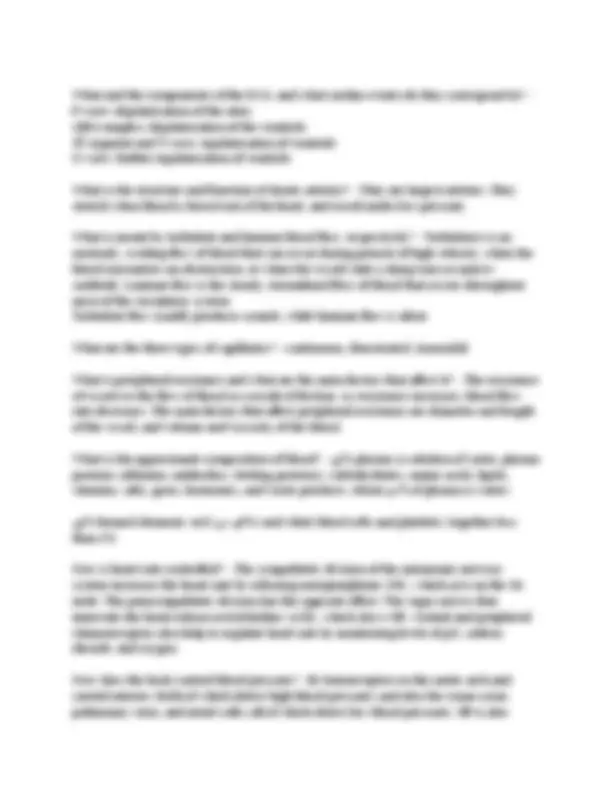
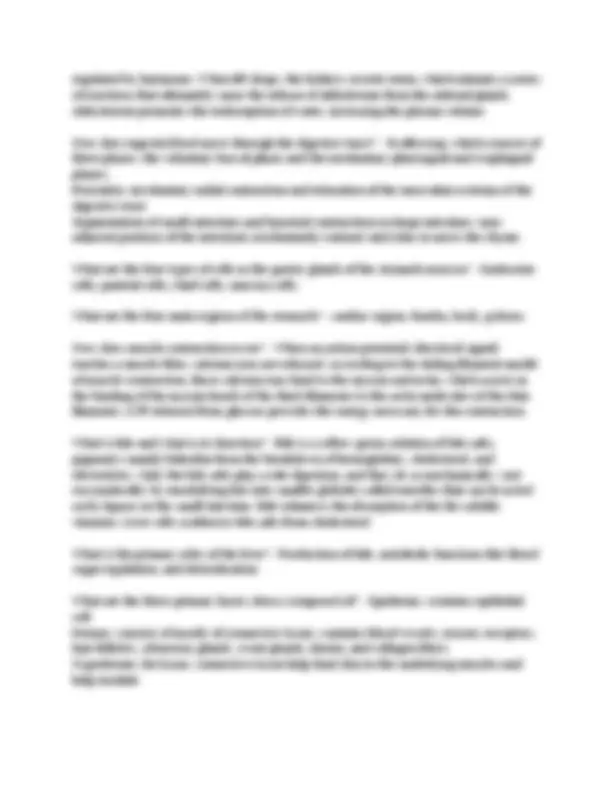
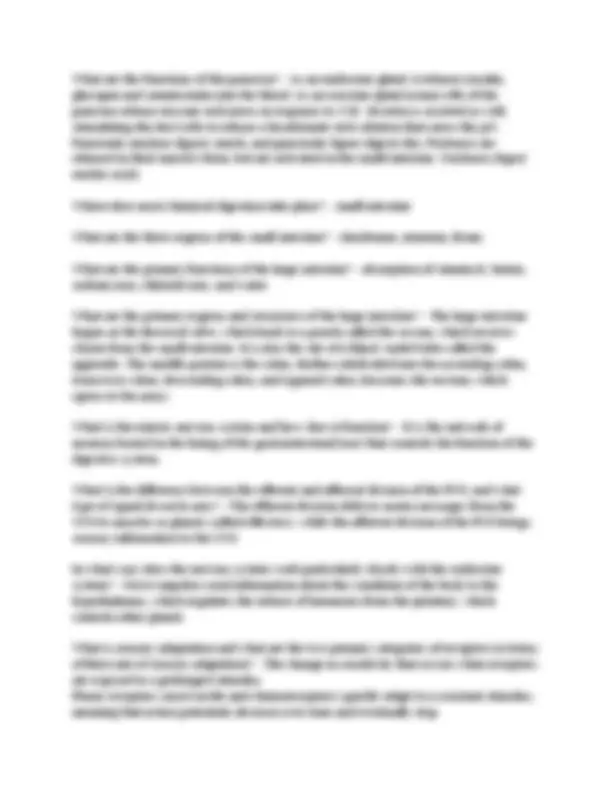
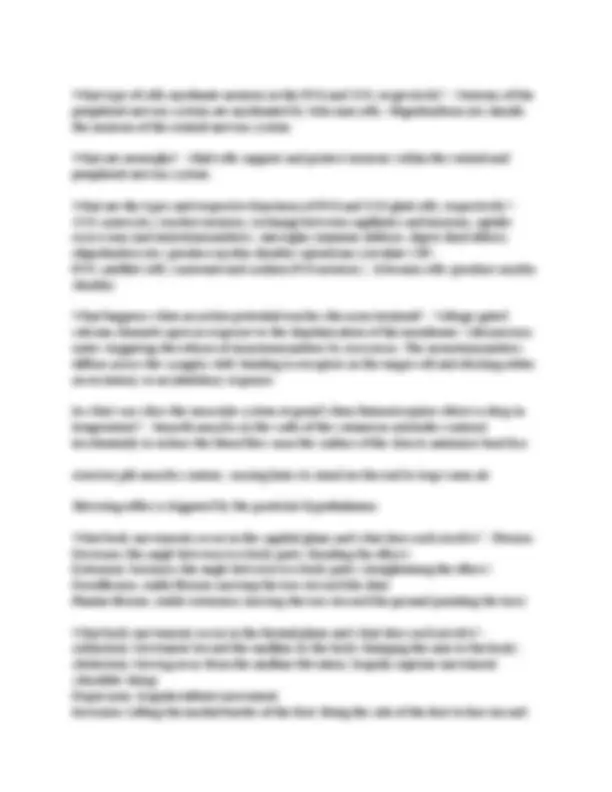
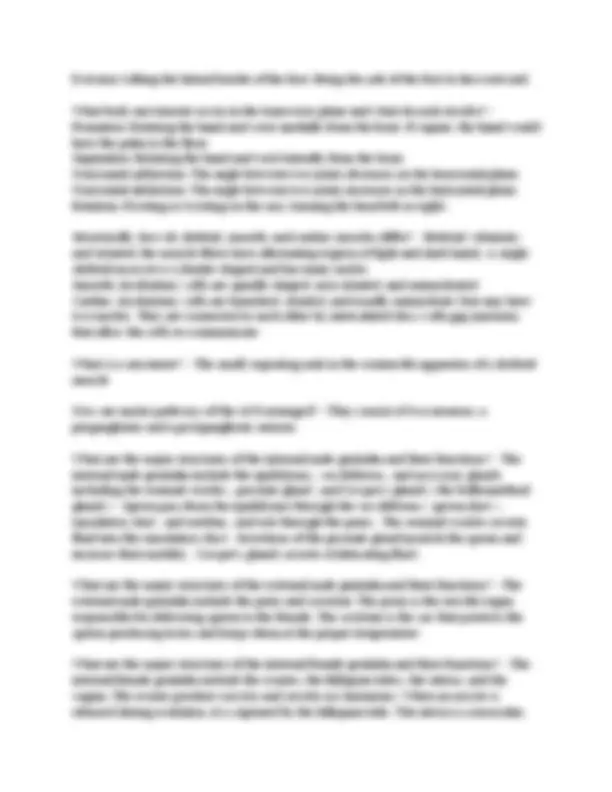
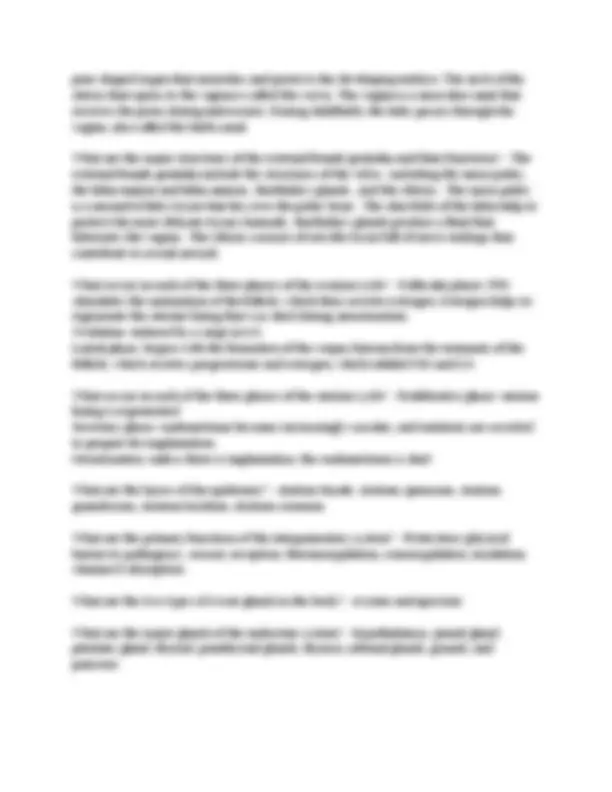
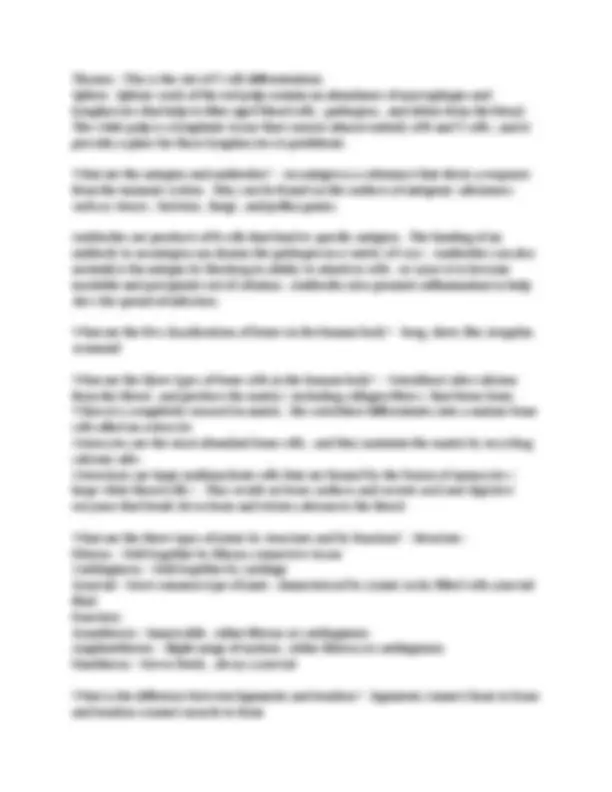
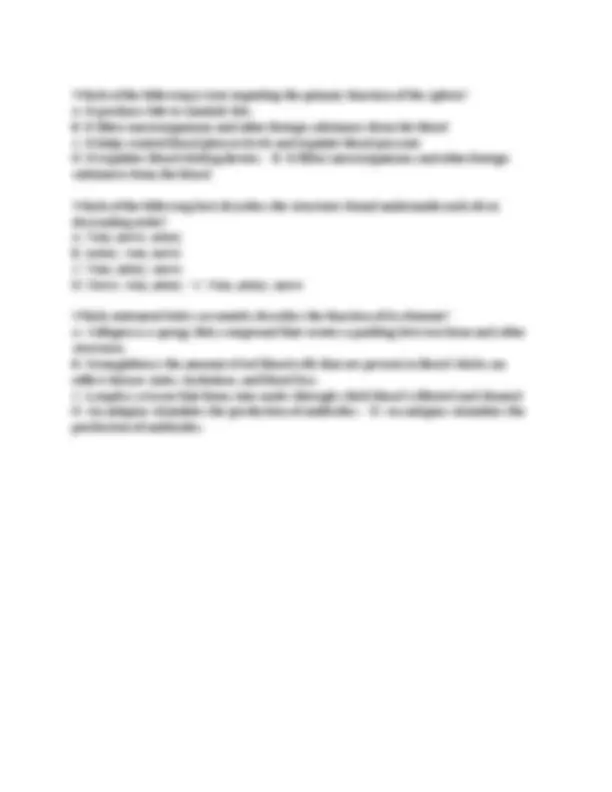
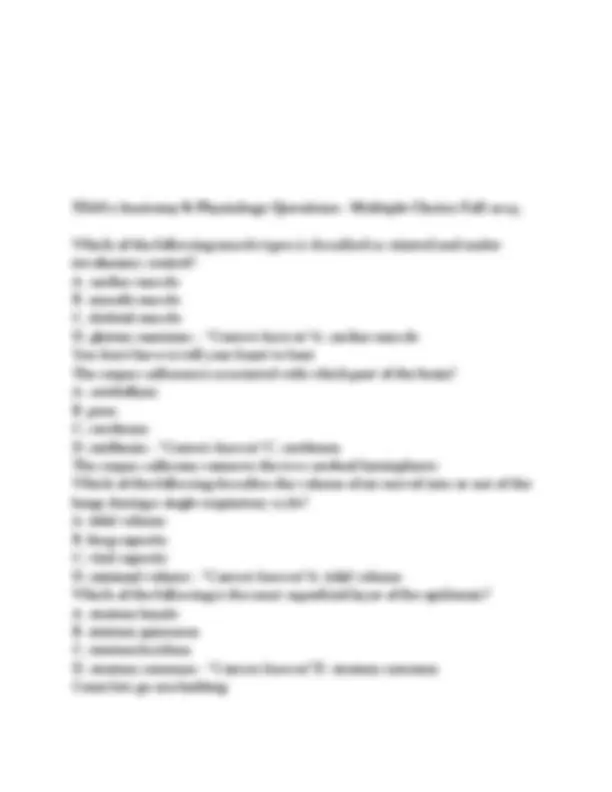
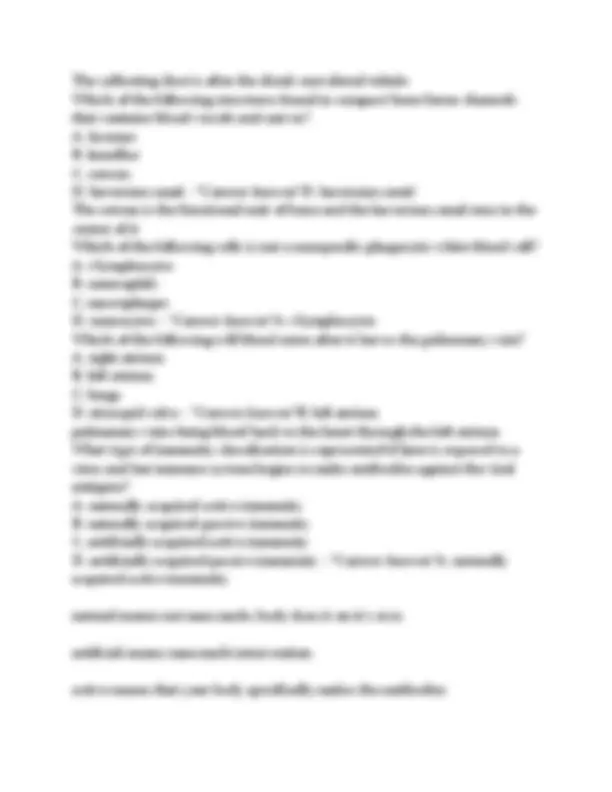
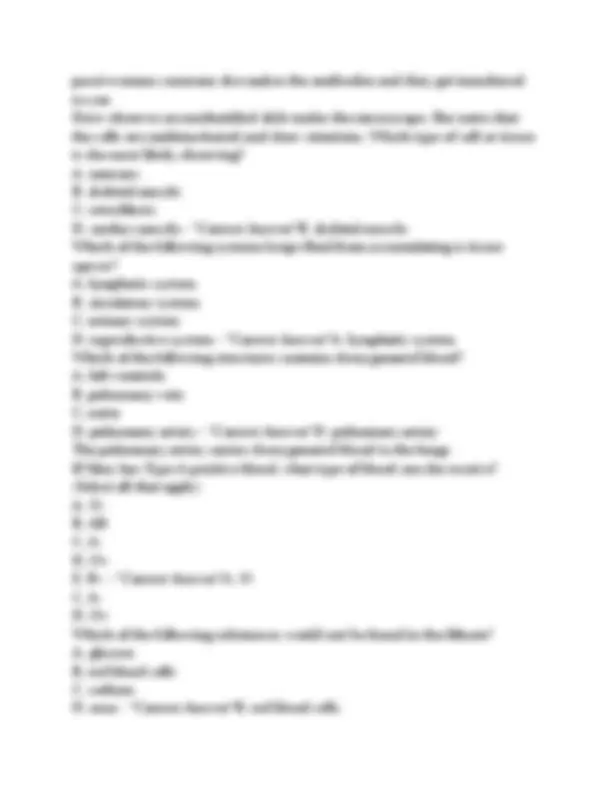
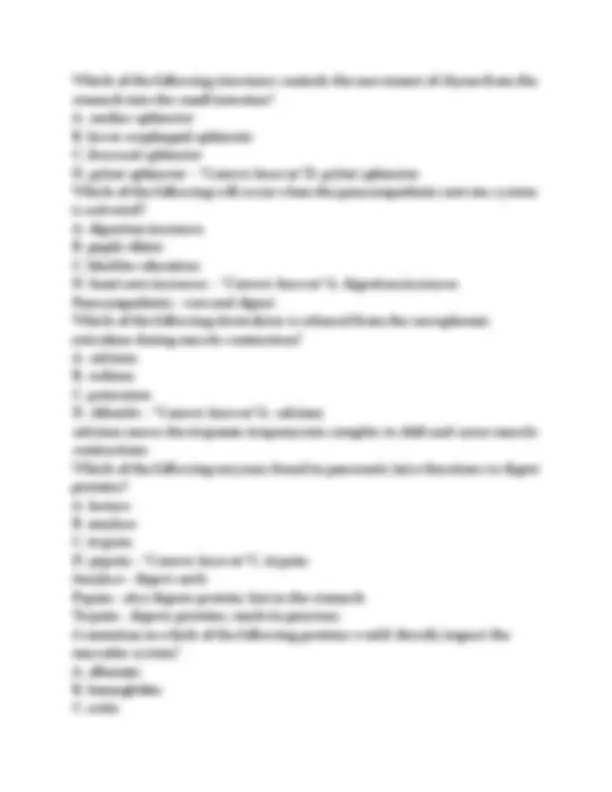
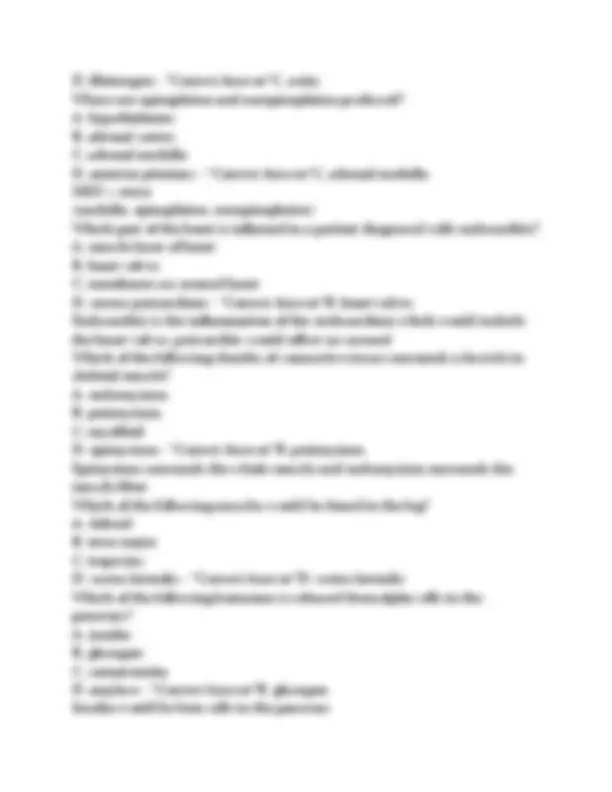
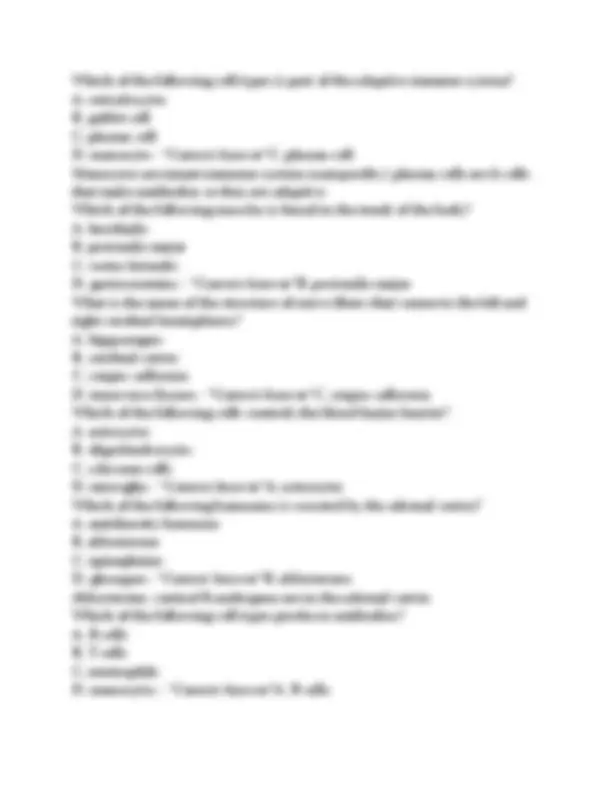
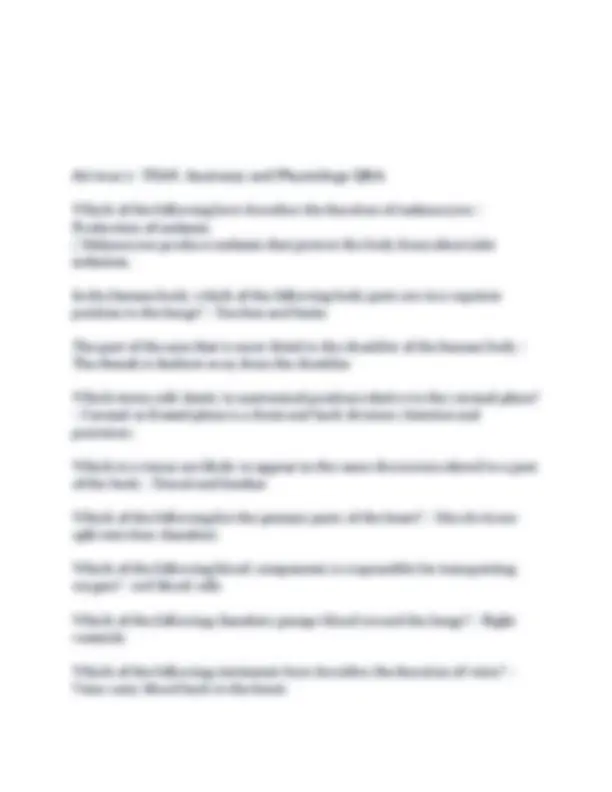
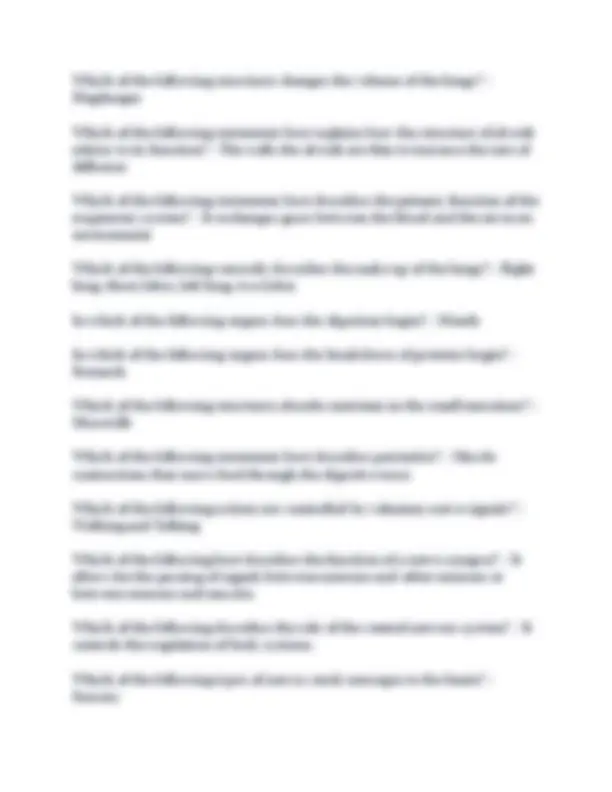
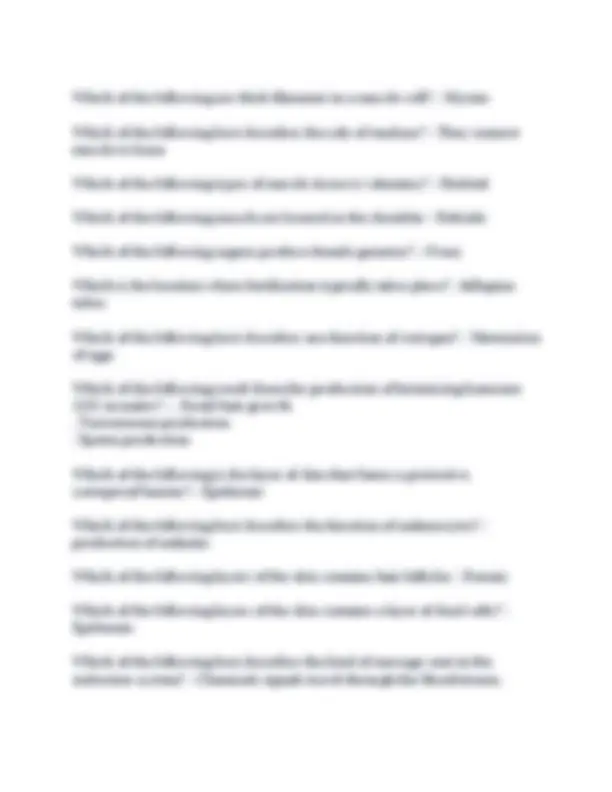
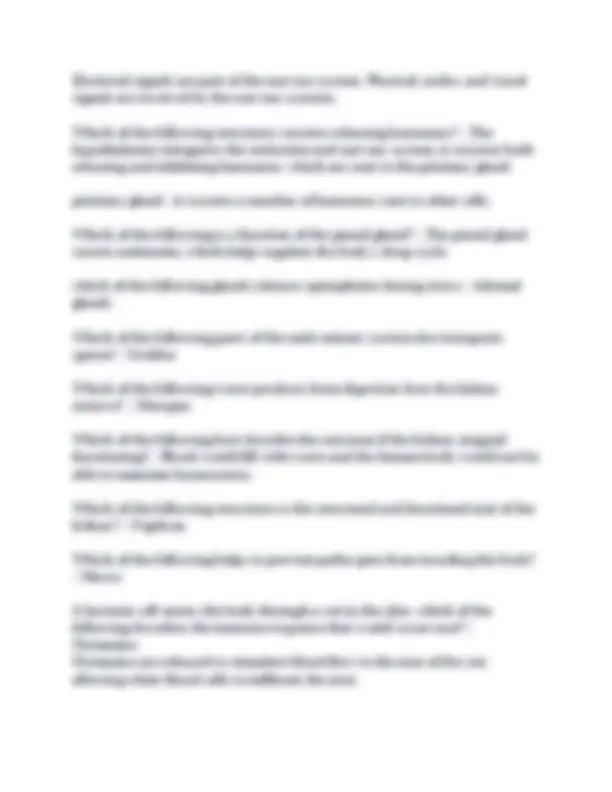
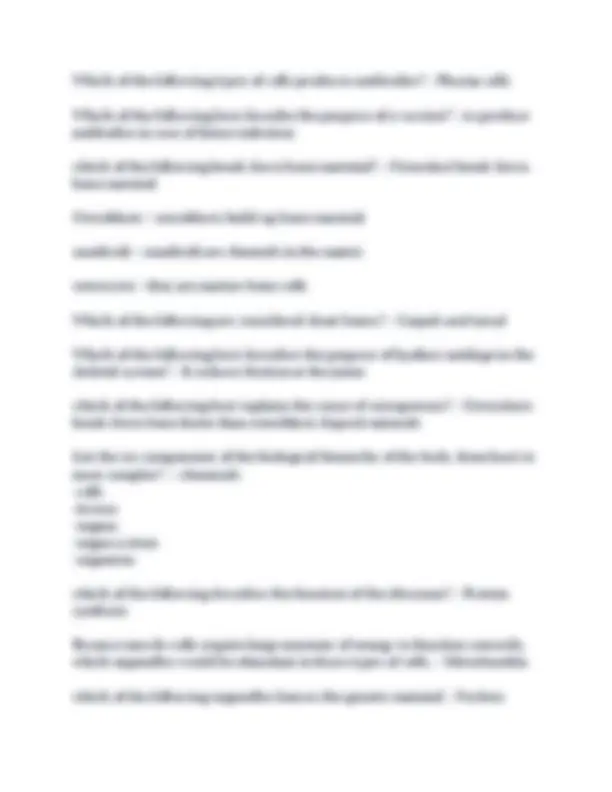
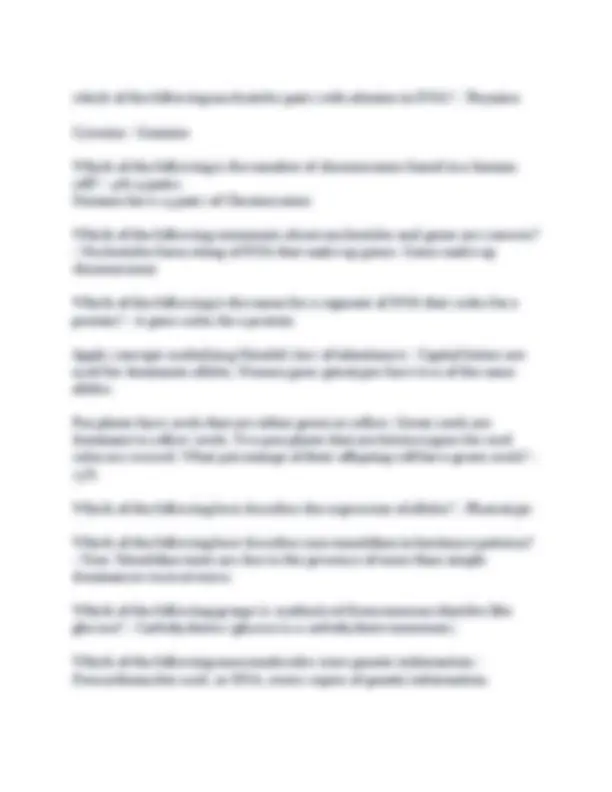
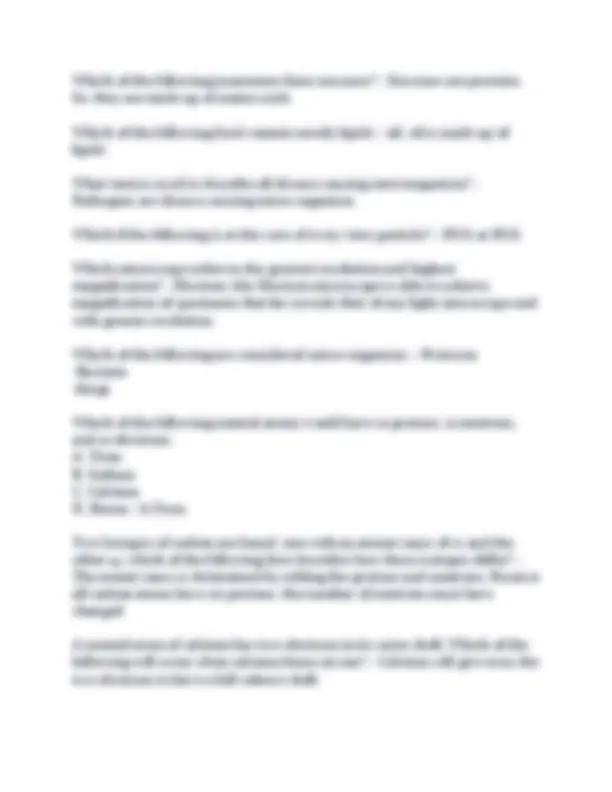
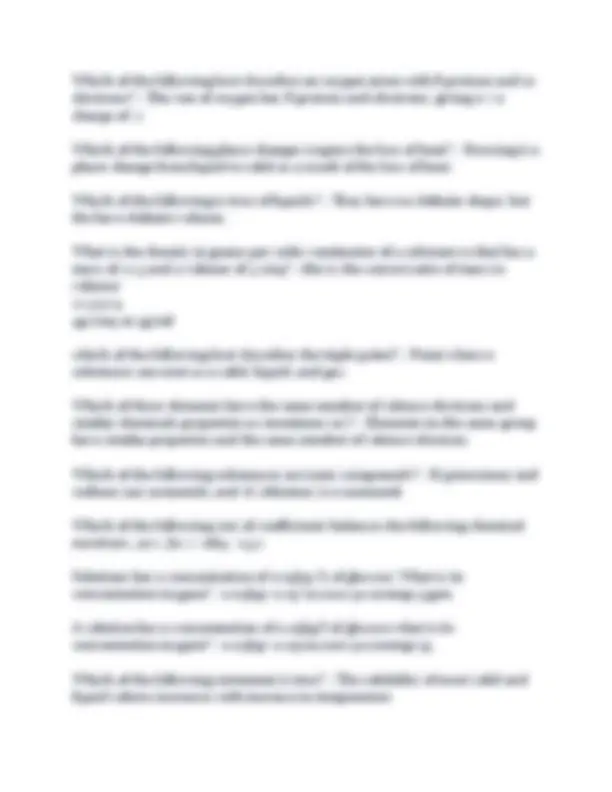
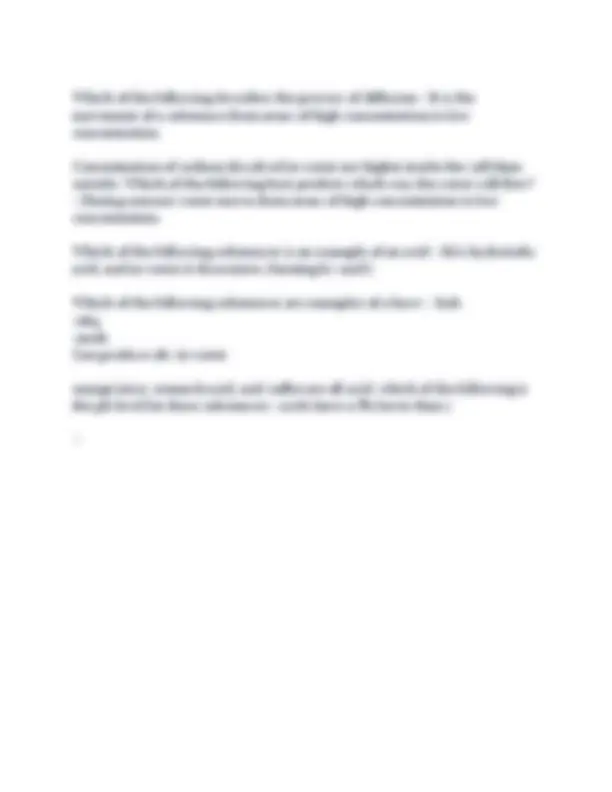
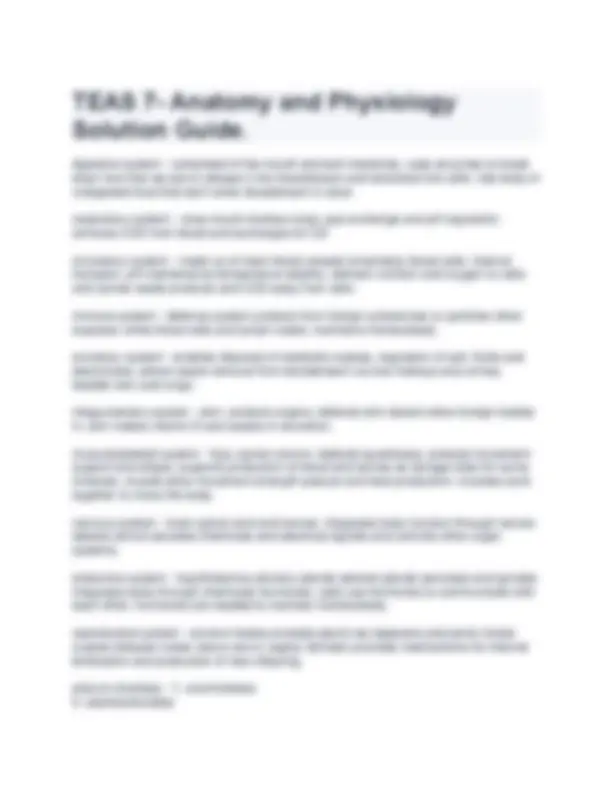
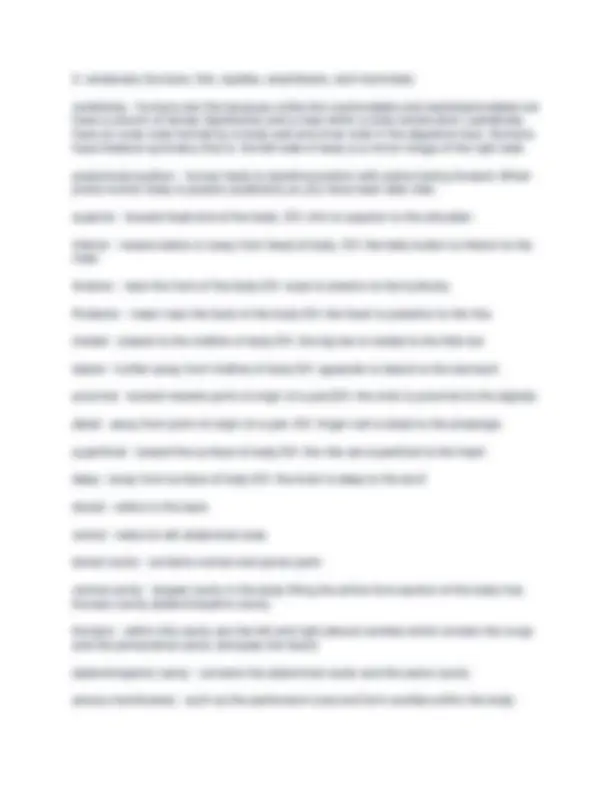
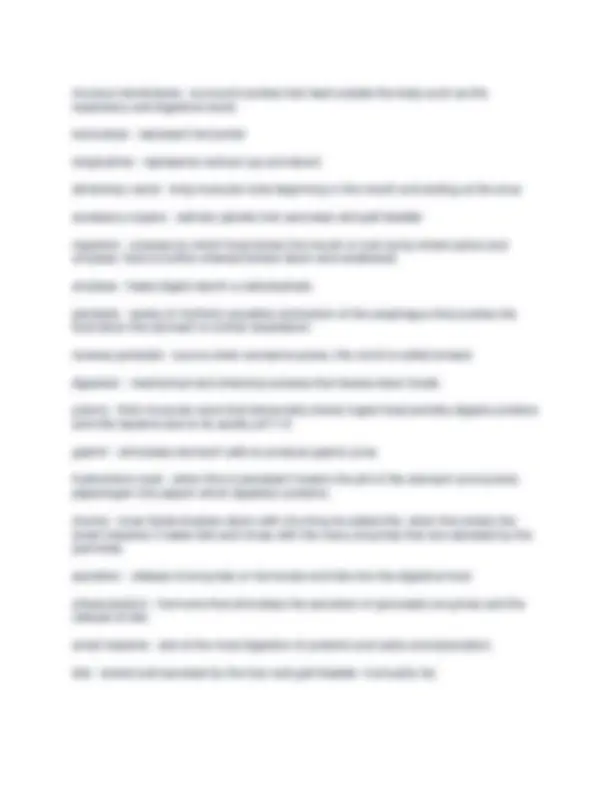
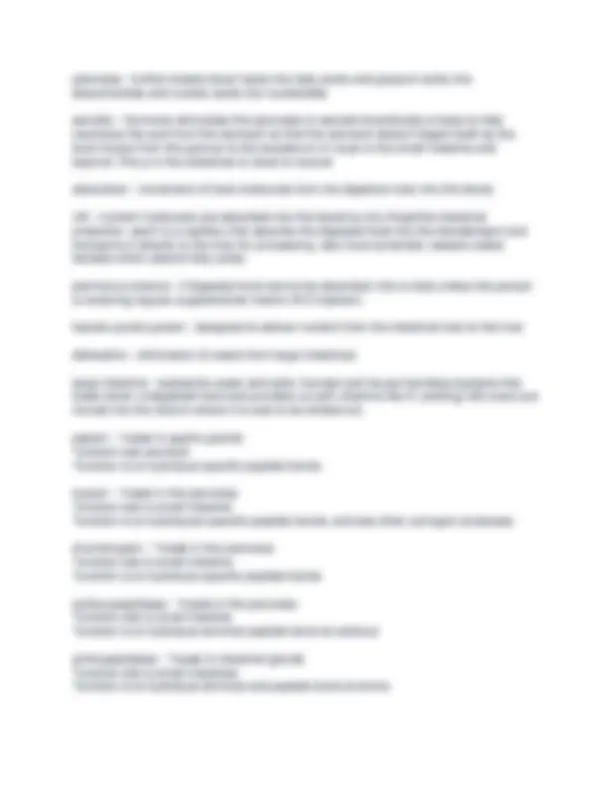
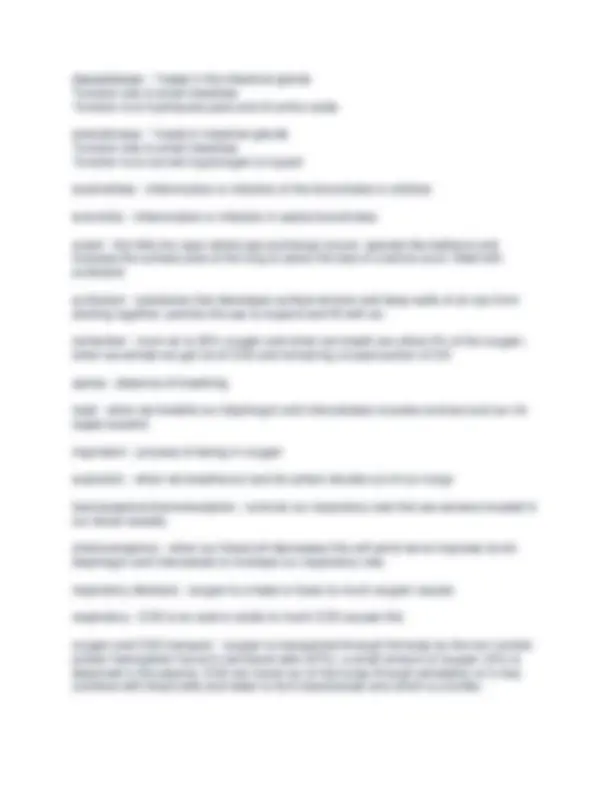
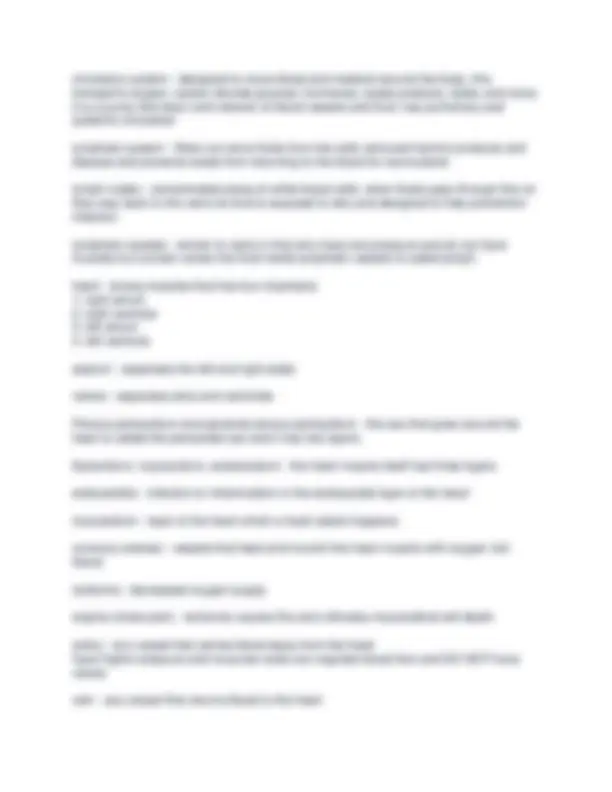
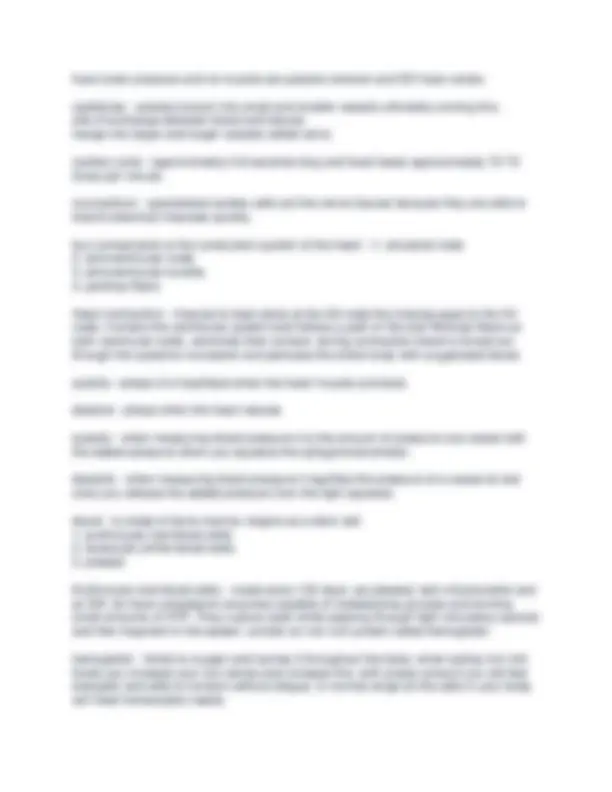
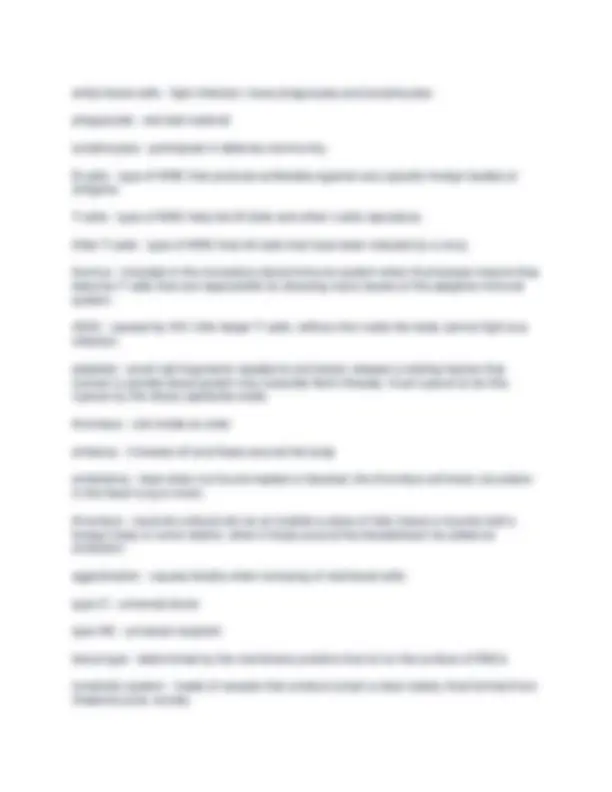
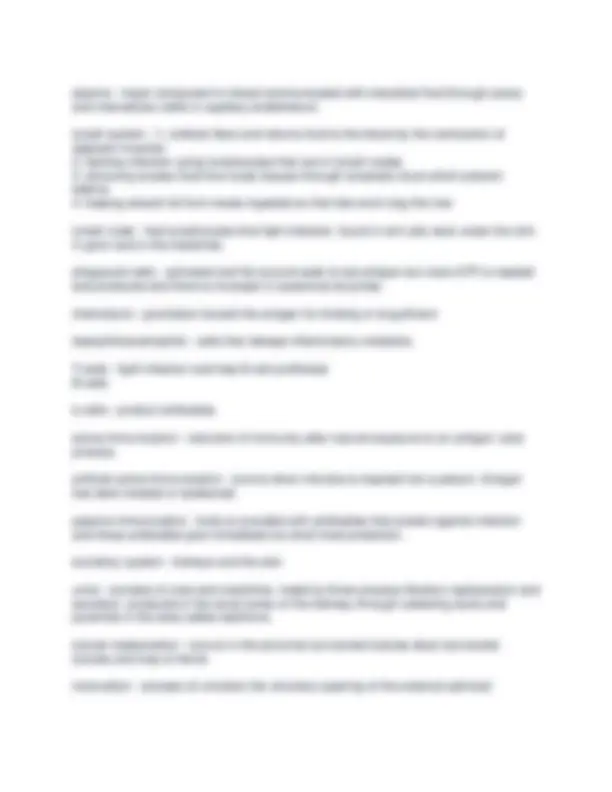
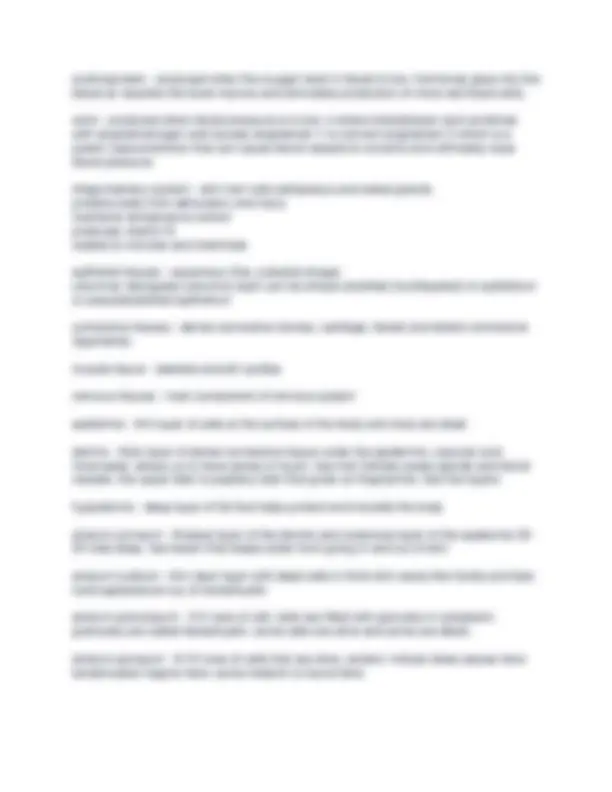
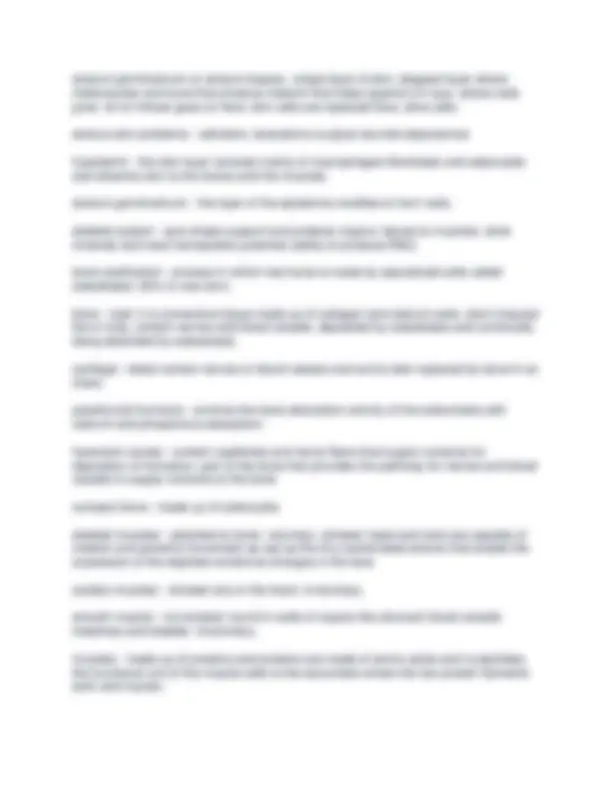
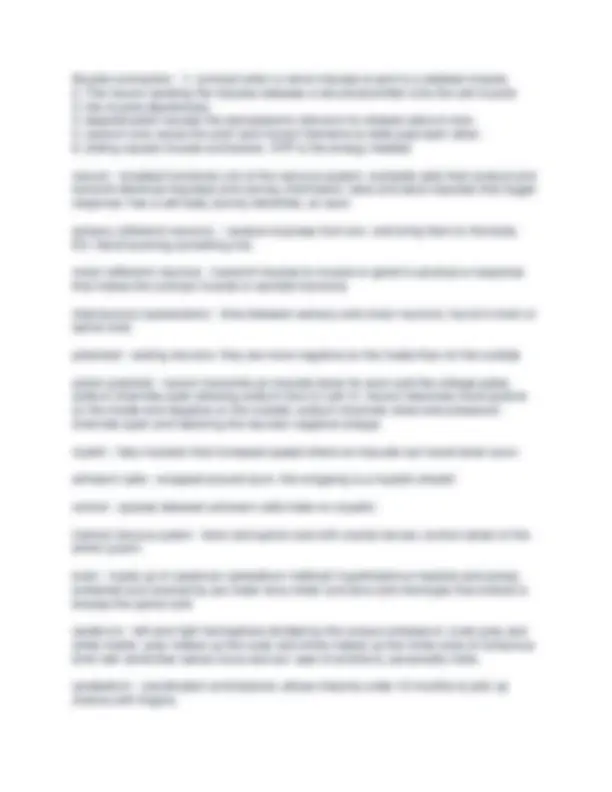
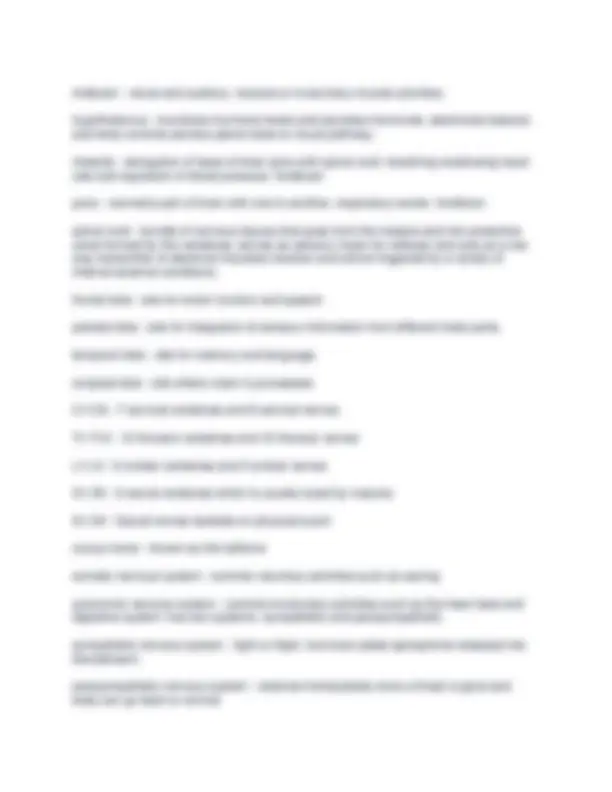
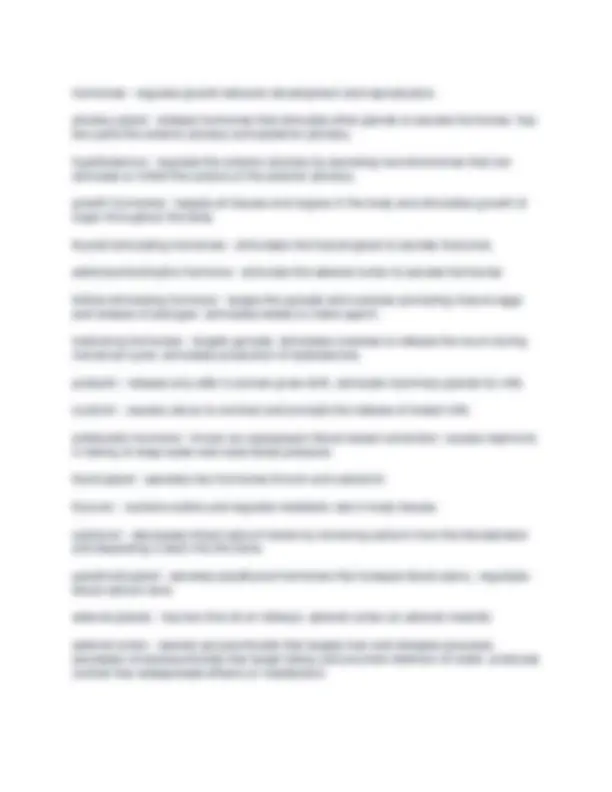
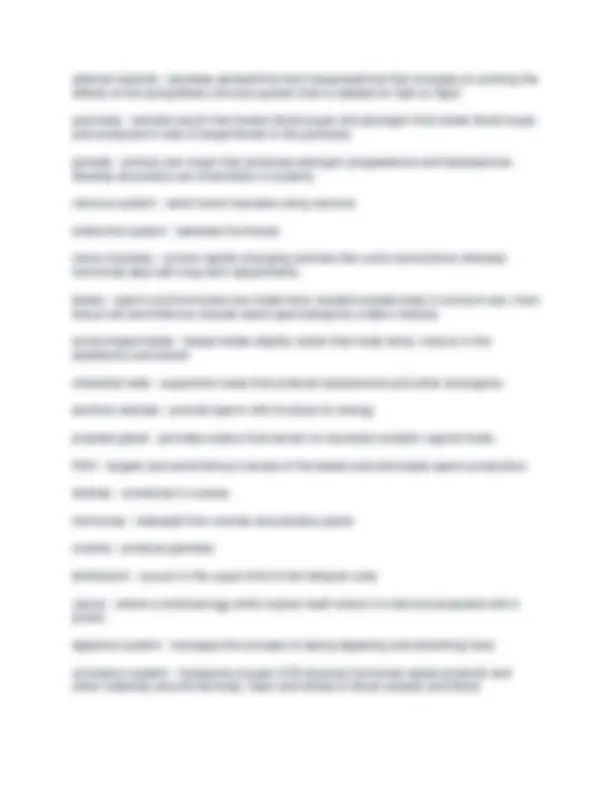
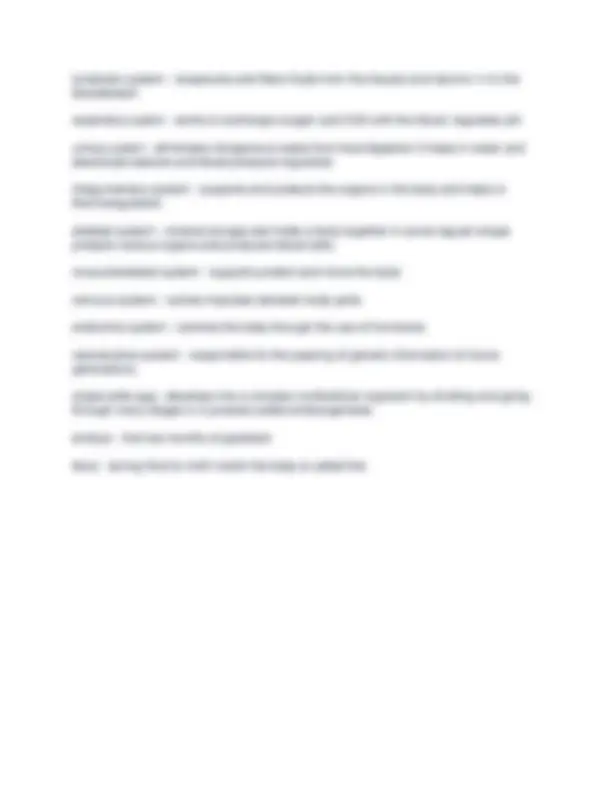


Study with the several resources on Docsity

Earn points by helping other students or get them with a premium plan


Prepare for your exams
Study with the several resources on Docsity

Earn points to download
Earn points by helping other students or get them with a premium plan
Community
Ask the community for help and clear up your study doubts
Discover the best universities in your country according to Docsity users
Free resources
Download our free guides on studying techniques, anxiety management strategies, and thesis advice from Docsity tutors
An overview of the key structures and functions of the cardiovascular and respiratory systems. It covers topics such as the pulmonary semilunar valve, bicuspid valve, aortic semilunar valve, blood pressure, oxygen regulation in the systemic and pulmonary circuits, the functions of the pancreas, the layers of the skin, and various other anatomical structures and physiological processes. The document also includes a series of multiple-choice questions testing the reader's understanding of these concepts. Overall, this document could be a valuable resource for students studying human anatomy and physiology, particularly those interested in the cardiovascular and respiratory systems and their integration with other bodily systems.
Typology: Exams
1 / 47

This page cannot be seen from the preview
Don't miss anything!








































What are the 3 body planes? - sagittal, frontal, transverse
What is the difference between medial and lateral? - Medial refers to near the midline of the body. Lateral refers to further away from the midline.
What is the difference between proximal and distal? - Proximal refers to structures closer to the center of the body. Distal refers to structure further away from the center of the body.
What do the terms anterior, posterior, superior, and inferior mean? - Anterior: in front Posterior: in back Superior: above, on top Inferior: below, on bottom
What are the abdominal quadrants? - RUQ, LUQ, RLQ, LLQ
What structures comprise the respiratory system? What is the primary function of the respiratory system? - Includes the nose, mouth, nasal cavity, sinuses, pharynx, larynx, trachea, bronchial tree and lungs Delivery oxygen to the cells of the body and remove waste in the form of carbon dioxide.
What is the generalized structure of the lungs? - The lungs are spongy, porous organs that occupy most of the thoracic cavity. A serous membrane called the pleura lines the thoracic cavity (parietal pleura) as well as the surface of the lungs (visceral pleura). The three-lobed right lung is separated from the two-lobed left lung by the mediastinum. The trachea forks into primary bronchi which enter the left and right lung (along with blood and lymphatic vessels) at a region called the hilum.
What are the divisions of the passages to the lungs? - The trachea splits into two primary bronchi (one for each lung), which split repeatedly into secondary bronchi, tertiary bronchi, and bronchioles to form the bronchial tree. The terminal bronchioles further divide into respiratory bronchioles, which are characterized by the presence of some alveoli. The respiratory bronchioles lead into alveolar ducts, which terminate in alveolar sacs.
What is the general mechanism of breathing? - When the diaphragm and external intercostals contract, the volume of the thoracic cavity increases, and the rib cage and sternum elevate and expand outwards. The increase of volume results in a decrease in intrapleural pressure, and a is enters the lungs in a process called inspiration. As the volume decrease in the thoracic cavity, the pressure of the intrapleural increase, and air leaves the lung in the more passive process of expiration
How is the circulatory system involved in thermoregulation? Thermos - Thermoreceptors detect changes in temperature. If body temperature is too warm,smooth muscle relaxes and arterioles dilate to release heat. If body temperature is too cold" smooth muscles contracts and arterioles constrict to hold heat.
What are the 3 layers of the heart? - epicardium, myocardium, endocardium
What are the different values of the heart and the functions? - Tricuspid valve: prevents backflow into atrium when ventricle contract. Pulmonary semilunar valve: prevents the return of blood into the right ventricle Bicuspid value: prevents blood from entering the left atrium when the ventricle contracts Aortic semilunar value: stops backflow of blood into the left ventricle as it leaves through the aorta
What is blood pressure, and what do the two numbers indicate? - The force per unit area that is exerted by the blood on the walls of the vessels. The first number refers to the systolic pressure, or the maximum pressure when the ventricles contract, forcing blood into the aorta and pulmonary trunk. Diastole is the period in which the ventricles relax and blood pressure is at its lowest point; diastolic pressure is the bottom number.
What are the primary differences between the systemic and pulmonary circulation? - Because the systemic circuit is much longer than the pulmonary circuit, blood pressure is higher. In the systemic circuit, blood in the arteries carries more oxygen than blood in the veins (the opposite is true for pulmonary circulation). When oxygen levels are low, vessels in the systemic circuit dilate to promote blood flow to tissues that need it, but in pulmonary circulation low blood oxygen triggers vasoconstriction, which redirects blood to better ventilated parts of the lung.
regulated by hormones. When BP drops, the kidneys secrete renin, which initiates a series of reactions that ultimately cause the release of aldosterone from the adrenal glands. Aldosterone promotes the reabsorption of water, increasing the plasma volume.
How does ingested food move through the digestive tract? - Swallowing: which consists of three phases: the voluntary buccal phase and the involuntary pharyngeal and esophageal phases. Peristalsis: involuntary radial contraction and relaxation of the muscularis externa of the digestive tract. Segmentation of small intestines and haustral contractions in large intestines: non- adjacent portions of the intestines involuntarily contract and relax to move the chyme.
What are the four types of cells in the gastric glands of the stomach mucosa? - Endocrine cells, parietal cells, chief cells, mucous cells
What are the four main regions of the stomach? - cardiac region, fundus, body, pylorus
How does muscle contraction occur? - When an action potential (electrical signal) reaches a muscle fiber, calcium ions are released. According to the sliding filament model of muscle contraction, these calcium ions bind to the myosin and actin, which assists in the binding of the myosin heads of the thick filaments to the actin molecules of the thin filaments. ATP released from glucose provides the energy necessary for the contraction.
What is bile and what is its function? - Bile is a yellow-green solution of bile salts, pigments (mainly bilirubin from the breakdown of hemoglobin), cholesterol, and electrolytes. Only the bile salts play a role digestion, and they do so mechanically ( not enzymatically) by emulsifying fats into smaller globules called micelles that can be acted on by lipases in the small intestine. Bile enhances the absorption of the fat-soluble vitamins. Liver cells synthesize bile salts from cholesterol
What is the primary roles of the liver? - Production of bile, metabolic functions like blood sugar regulation, and detoxification
What are the three primary layers skin is composed of? - Epidermis: contains epithelial cell Dermis: consists of mostly of connective tissue, contains blood vessels, sensory receptors, hair follicles, sebaceous glands, sweat glands, elastin, and collagen fibers Hypodermis: fat tissue, connective tissue help bind skin to the underlying muscles and help insulate
What are the functions of the pancreas? - As an endocrine gland, it releases insulin, glucagon and somatostatin into the blood. As an exocrine gland acinar cells of the pancreas release enzyme-rich juices in response to CCK. Secretin is secreted as well, stimulating the duct cells to release a bicarbonate-rich solution that raises the pH. Pancreatic amylase digests starch, and pancreatic lipase digests fats. Proteases are released in their inactive form, but are activated in the small intestine. Nucleases digest nucleic acids
Where does most chemical digestion take place? - small intestine
What are the three regions of the small intestine? - duodenum, jejunum, ileum
What are the primary functions of the large intestine? - absorption of vitamin K, biotin, sodium ions, chloride ions, and water
What are the primary regions and structures of the large intestine? - The large intestine begins at the ileocecal valve, which leads to a pouch called the cecum, which receives chyme from the small intestine. It is also the site of a blind- ended tube called the appendix. The middle portion is the colon, further subdivided into the ascending colon, transverse colon, descending colon, and sigmoid colon (becomes the rectum, which opens to the anus).
What is the enteric nervous system and how does it function? - It is the network of neurons buried in the lining of the gastrointestinal tract that controls the function of the digestive system.
What is the difference between the efferent and afferent division of the PNS, and what type of signal do each carry? - The efferent division delivers motor messages from the CNS to muscles or glands (called effectors), while the afferent division of the PNS brings sensory information to the CNS.
In what ways does the nervous system work particularly closely with the endocrine system? - Nerve impulses send information about the condition of the body to the hypothalamus, which regulates the release of hormones from the pituitary, which controls other glands.
What is sensory adaptation and what are the two primary categories of receptors in terms of their rate of sensory adaptation? - The change in sensitivity that occurs when receptors are exposed to a prolonged stimulus. Phasic receptors (most tactile and chemoreceptors) quickly adapt to a constant stimulus, meaning that action potentials decrease over time and eventually stop.
Medulla : connects the spinal cord to the brain ; it has an important role with the ANS in the circulatory and respiratory system.
What are the functions of the meninges and the basic characteristics of each? - They line the cavity , surround the brain and the spinal cord , and contain cerebrospinal fluid in the subarachnoid space.
What are the names and functions of each of the 12 pairs of cranial nerves? - 1. olfactory - smell
What are the two layers of the spinal cord? - It is made of an exterior layer of white matter that surrounds an interior core of grey matter
How do afferent and efferent fibers enter/ exit the spinal cord? - Afferent fibers enter into the posterior/dorsal aspect of the spinal cord (a region called the posterior grey horn) through the anterior root, while efferent fibers exit on the anterior/ventral aspect (the anterior grey horn) through the posterior root
What is a reflex arc? - a neural pathway that controls a reflex action
What are positive and negative feedback loops, respectively? - Positive feedback loops are less common and sometimes harmful because they enhance the stimuli rather than inhibit them. Negative feedback loops inhibit the stimulus or the deviation from homeostasis to bring the body back to the set point.
What are the structural components of a neuron? - cell body, dendrites, axon
What is myelin and what does it do? - A lipid-based coating that insulates the axon of many neurons much like the coating on electrical wire. It also increases the rate at which an impulse can travel.
What type of cells myelinate neurons in the PNS and CNS, respectively? - Neurons of the peripheral nervous system are myelinated by Schwann cells. Oligodendroocytes sheath the neurons of the central nervous system
What are neuroglia? - Glial cells support and protect neurons within the central and peripheral nervous system
What are the types and respective functions of PNS and CNS glial cells, respectively? - CNS: astrocytes (Anchor neurons, exchange between capillaries and neurons, uptake excess ions and neurotransmitters), microglia (immune defense, digest dead debris), oligodendrocytes (produce myelin sheaths) ependyma (circulate CSF) PNS: satellite cells (surround and cushion PNS neurons ), Schwann cells (produce myelin sheaths)
What happens when an action potential reaches the axon terminal? - Voltage-gated calcium channels open in response to the depolarization of the membrane. Calcium ions enter, triggering the release of neurotransmitters by exocytosis. The neurotransmitters diffuse across the synaptic cleft, binding to receptors in the target cell and eliciting either an excitatory or an inhibitory response.
In what ways does the muscular system respond when themoreceptors detect a drop in temperature? - Smooth muscles in the walls of the cutaneous arterioles contract involuntarily to reduce the blood flow near the surface of the skin to minimize heat loss
Arrector pili muscles contrac, causing hairs to stand on the end to trap warm air
Shivering reflex is triggered by the posterior hypothalamus
What body movements occur in the sagittal plane and what does each involve? - Flexion: Decreases the angle between two body parts (bending the elbow) Extension: Increases the angle between two body parts (straightening the elbow) Dorsiflexion: Ankle flexion (moving the toes toward the shin) Plantar flexion: Ankle extension (moving the toes toward the ground/pointing the toes)
What body movements occur in the frontal plane and what does each involve? - Adduction: Movement toward the midline/to the body (bringing the arm to the body). Abduction: Moving away from the midline Elevation: Scapula superior movement (shoulder shrug) Depression: Scapula inferior movement Inversion: Lifting the medial border of the foot. Bring the sole of the foot to face inward.
pear-shaped organ that nourishes and protects the developing embryo. The neck of the uterus that opens to the vagina is called the cervix. The vagina is a muscular canal that receives the penis during intercourse. During childbirth, the baby passes through the vagina, also called the birth canal.
What are the major structures of the external female genitalia and their functions? - The external female genitalia include the structures of the vulva , including the mons pubis , the labia majora and labia minora , Bartholin's glands , and the clitoris. The mons pubis is a mound of fatty tissue that lies over the pubic bone. The skin folds of the labia help to protect the more delicate tissues beneath. Bartholin's glands produce a fluid that lubricates the vagina. The clitoris consists of erectile tissue full of nerve endings that contribute to sexual arousal.
What occurs in each of the three phases of the ovarian cycle? - Follicular phase: FSH stimulates the maturation of the follicle, which then secretes estrogen. Estrogen helps to regenerate the uterine lining that was shed during menstruation. Ovulation: induced by a surge in LH. Luteal phase: begins with the formation of the corpus luteum from the remnants of the follicle, which secretes progesterone and estrogen, which inhibit FSH and LH.
What occurs in each of the three phases of the uterine cycle? - Proliferative phase: uterine lining is regenerated Secretory phase: endometrium becomes increasingly vascular, and nutrients are secreted to prepare for implantation Menstruation: unless there is implantation, the endometrium is shed
What are the layers of the epidermis? - stratum basale, stratum spinosum, stratum granulosum, stratum lucidum, stratum corneum
What are the primary functions of the integumentary system? - Protection (physical barrier to pathogens), sensory reception, thermoregulation, osmoregulation, insulation, vitamin D absorption.
What are the two types of sweat glands in the body? - eccrine and apocrine
What are the major glands of the endocrine system? - hypothalamus, pineal gland, pituitary gland, thyroid, parathyroid glands, thymus, adrenal glands, gonads, and pancreas
What is the difference between an endocrine gland and exocrine gland? - Endocrine glands release substances directly into the bloodstream or tissues. Examples of these glands include the thyroid, pituitary, and adrenal glands.
Exocrine glands release substances through ducts to the outside of the body. Examples of these glands include the sweat, gastric, and salivary glands.
What are the main types of hormones? - Steroids ( derived from cholesterol ) and non - steroids.
What hormones are produced in the pituitary gland and what do they do? - Thyroid stimulating hormone : Targets the thyroid ; stimulates the secretion of thyroid hormones . Adrenocorticotropic hormone : Targets the adrenal cortex ; stimulates the release of glucocorticoids and mineralocorticoids. Growth hormone : Targets muscle and bone ; stimulates growth. Follicle stimulating hormone : Targets the gonads ; stimulates the maturation of sperm cells and ovarian follicles. Luteinizing hormone : Targets the gonads ; stimulates the production of sex hormones ; surge stimulates ovulation in females. Prolactin : Targets the mammary glands ; stimulates production of milk.
What hormones are produced in the thyroid gland and what do they do? - Triiodothyronine ( T3 ) : Targets most cells ; stimulates cellular metabolism. Thyroxine ( T4 ) : Targets most cells ; stimulates cellular metabolism. Calcitonin : Targets bone and kidneys ; lowers blood calcium.
What hormones are produced in the pancreas and what do they do? - Insulin : Targets the liver , muscle , and adipose tissue ; decreases blood glucose. Glucagon : Targets the liver , increases blood glucose. Growth hormone IH ( GHIH ; somatostatin ) : Inhibits the secretion of insulin and glucagon.
What hormones are produced in the adrenal cortex and what do they do? - Mineralocorticoids: targets the kidneys; increase the retention of Na+ and excretion of K+ Glucocorticoid: targets most tissues; released in response to long term stressors, increase blood glucose Androgens: targets most tissues, stimulates development of secondary sex characteristics
What hormones are produced in the GI tract and what do they do? - Gastrin : Targets the stomach ; stimulates the release of HCI.
Thymus : This is the site of T cell differentiation. Spleen : Splenic cords of the red pulp contain an abundance of macrophages and lymphocytes that help to filter aged blood cells , pathogens , and debris from the blood. The white pulp is a lymphatic tissue that consists almost entirely of B and T cells , and it provides a place for these lymphocytes to proliferate.
What are the antigens and antibodies? - An antigen is a substance that elicits a response from the immune system. They can be found on the surfaces of antigenic substances such as viruses , bacteria , fungi , and pollen grains.
Antibodies are products of B cells that bind to specific antigens. The binding of an antibody to an antigen can disarm the pathogen in a variety of ways. Antibodies can also neutralize the antigen by blocking its ability to attach to cells , or cause it to become insoluble and precipitate out of solution. Antibodies also promote inflammation to help slow the spread of infection.
What are the five classifications of bones in the human body? - long, short, flat, irregular, sesamoid
What are the three types of bone cells in the human body? - Osteoblasts take calcium from the blood , and produce the matrix ( including collagen fibers ) that forms bone. When it is completely encased in matrix , the osteoblast differentiates into a mature bone cell called an osteocyte Osteocytes are the most abundant bone cells , and they maintain the matrix by recycling calcium salts. Osteoclasts are large multinucleate cells that are formed by the fusion of monocytes ( large white blood cells ). They reside on bone surfaces and secrete acid and digestive enzymes that break down bone and return calcium to the blood.
What are the three types of joints by structure and by function? - Structure : Fibrous - Held together by fibrous connective tissue Cartilaginous - Held together by cartilage Synovial - Most common type of joint ; characterized by a joint cavity filled with synovial fluid Function : Synarthrosis - Immovable , either fibrous or cartilaginous Amphiarthrosis - Slight range of motion , either fibrous or cartilaginous Diarthrosis - Moves freely , always synovial
What is the difference between ligaments and tendons? - ligaments connect bone to bone and tendons connect muscle to bone
Which of the following is true regarding the primary function of the spleen? A. It produces bile to emulsify fats. B. It filters microorganisms and other foreign substances from the blood C. It helps control blood glucose levels and regulate blood pressure. D. It regulates blood clotting factors. - B. It filters microorganisms and other foreign substances from the blood
Which of the following best describes the structures found underneath each rib in descending order? A. Vein, nerve, artery B. Artery, vein, nerve C. Vein, artery, nerve D. Nerve, vein, artery - C. Vein, artery, nerve
Which statement below accurately describes the function of its element? A. Collagen is a spongy fatty compound that creates a padding between bone and other structures. B. Hemoglobin is the amount of red blood cells that are present in blood which can reflect disease states, hydration, and blood loss. C. Lymph is a tissue that forms into nodes through which blood is filtered and cleaned. D. An antigens stimulates the production of antibodies. - D. An antigens stimulates the production of antibodies.